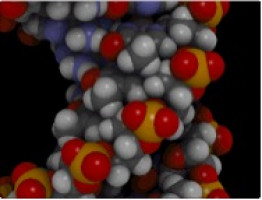
Researchers have mapped the damage of ultraviolet radiation on individual units of DNA, opening a new avenue in the search for how sunlight causes skin cancer and what might be done to prevent it.
"This technique gives you almost a satellite-view image of all the damage across the genome," said John Wyrick, a Washington State Univeristy geneticist specialising in DNA repair and corresponding author of a study out this week in the journal Proceedings of the National Academy of Sciences.
Wyrick and WSU colleagues Peng Mao, Michael Smerdon and Steven Roberts irradiated yeast cells and looked for patterns of damage at the level of individual base pairs, the DNA building blocks whose order serves as an organism's blueprint.
Some parts of the genome were more damaged than others, said Wyrick, offering clues to how and why damage occurs.
Wyrick used a large DNA model made of interlocking pieces of plastic to explain.
The model shows the classic double helix of DNA strands going in opposite directions with nucleotides linking to each other across the strands to form base pairs.
Inside the nucleus of a human cell, a single unit of DNA will stretch to some 6 billion nucleotides.
Ostensibly to save space, they are spooled around structures called histones to form units called nucleosomes.
Until recently, researchers looked for damage along specific stretches of DNA.
But using a technique that lets them map the genome in much greater detail, Wyrick and his team saw that DNA was more damaged when it faced away from the histone.
Researchers have expected this but never before seen it in such detail and resolution.
Wyrick and his colleagues also saw less damage around transcription factors, proteins that bind to specific, short stretches of DNA and regulate gene expression by controlling which genes are turned on and off.
Presumably, the transcription factors are putting kinks in the DNA that prevent it from being damaged, he said.
Once damaged, the DNA can have even greater kinking and more problems, Wyrick said.
"It will block all sorts of processes," he said. "It will block replication. It will block transcription during gene expression. If it doesn't get repaired, it's very detrimental to the cell."
Wyrick said he is now wondering if the same patterns of damage can be seen in outright mutations -- uncorrected damage, basically -- or the cancers that can grow from them.
Wyrick stressed that this work is just one of many steps needed to get a greater understanding of how cancers form.
Identifying the key players behind mutations and cancer may not immediately lead to therapies, he said, but it's important to understand the process.
"It's possible that some of these same mechanisms that we've seen in yeast may be influencing the amount of damage that is forming and how quickly it is repaired in human cells," he said. "If we could figure that out, then we might have a better understanding of what types of genes are more frequently being mutated. It might guide intervention down the road."
The World Cancer Declaration recognises that to make major reductions in premature deaths, innovative education and training opportunities for healthcare workers in all disciplines of cancer control need to improve significantly.
ecancer plays a critical part in improving access to education for medical professionals.
Every day we help doctors, nurses, patients and their advocates to further their knowledge and improve the quality of care. Please make a donation to support our ongoing work.
Thank you for your support.